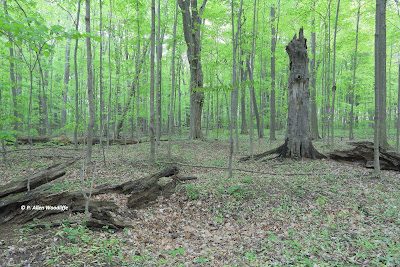This first image shows it relative to the north end of Chatham. The large Superstore/Walmart shopping area in north Chatham is visible in the lower left hand corner. Towards the upper right hand corner is an area marked with 'M'. This is the location of McKerrall Woods. So distance isn't a factor to explain why it is not known and seldom visited.
This closer map shows the configuration, outlined by the blue line. The gravel road along the bottom of the photo is Darrell Line. At the bottom of the image is an 'X'. That is where the small parking lot is, just a kilometre or so east of DeGeest Line. What makes this site difficult to find is that in spite of there being a small parking lot, the woodlot is at least a couple of hundred metres away from the parking lot, and even though there is a sign in the parking lot, the white cedars that were planted along it quite a few years ago have grown up and completely hidden the sign. To access the woodlot, after parking in the small lot, one can walk through a red steel gate and along a grassy path and cedar hedge to the edge of the woods. There are no trails here, you just wander wherever you like.
This woodlot was given to the municipality many years ago. I don't know any of those details. However it is publicly owned and accessible. It is about 20 hectares (50 acres) in size and the mixed upland/lowland forest is in nice condition.
Some parts of the woodlot have a fairly dense understorey, as shown in the next photo.
Other parts are quite open.
During late April and early May, there is a good diversity of spring wildflowers, some of which are shown below.
 |
| White Baneberry |
 |
| Jack-in-the-pulpit |
 |
| Squirrel Corn |
 |
| Red Trillium |
 |
| Long-spurred Violet |
During the bird migration, a number of birds can be found, including migrating warblers. The site has not been heavily birded, as the modest number of species recorded for the site to date (45) would indicate. If it was birded more intensively, this number could likely be doubled. For example the next site I will be describing is a smaller woodlot, but has 109 species known, primarily because it is visited more often.
 |
| Cape May Warbler, a migrant |
Birds typical of this size of woodlot include species such as Great Horned Owl, Red-tailed Hawk, various woodpecker species, one or two warblers, flycatchers, Baltimore Oriole, Cedar Waxwing, etc.
 |
| Baltimore Oriole |
 |
| Cedar Waxwing |
The lowland forest part does support a fairly healthy population of Poison Ivy. I usually wear rubber boots to minimize contact with it.
 |
| Typical lowland forest with shallow pools of water |
If you look a little higher up the trunk, you may notice the bark looking quite mottled like either of the next two photos.
One of the reasons I go there several times a year is to enjoy the peace and quiet. Being so far off the road, and at times when farm machinery isn't very active, it can really be pleasantly quiet, especially when you have the place to yourself. On occasion you may hear cattle from a property nearby.
Another reason I enjoy this place is because there are a few impressively large trees, the older growth characteristics giving one a few hints of what the area might have looked like before settlement. Here are a few I've captured on digital film. This first one is an American Beech, and is slightly less than one metre in diameter. That makes it one of the largest diameter American Beech in the province!
 |
| American Beech |
This next one is a Swamp White Oak, and is a good size for the species.
A really large individual is this Silver Maple, measuring 143 cm in diameter. Silver Maples grow quickly since they grow in wet sites, but don't live nearly as long as many other trees. However their rapid growth even in such a relatively short time can give them some impressive diameter.
McKerrall Woods is always a treat to explore. While the walking conditions can be a little wet in the spring, depending on the year, the late summer and fall period is very enjoyable, shuffling through the leaves or looking through the amazing golden colours.
Check it out.....I'm sure you will be glad you did!

















I should check out this little gem some day!
ReplyDeleteIndeed you should...it isn't far away. I'm sure you can add considerably to the current ebird list.
DeleteExcellent find
ReplyDelete